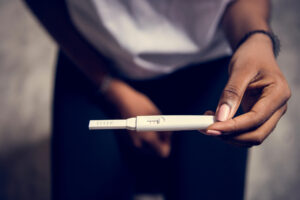Uterine Fibroid Embolization (UFE) is an effective, minimally invasive fibroid treatment. For years, we didn't know how UFE affects fertility. Women who wanted kids had myomectomies (surgical removal of fibroids.) Now, thanks to several studies, we're learning more about fertility after UFE. And how many women get pregnant after UFE, both of which may just be changing that school of thought.
Today, we'll explore how UFE may affect your chances of having a family. But first we'll walk you through the procedure. And let you know what your recovery will look like, so you can know what to expect right after having a UFE procedure.

As we mentioned, UFE is a less invasive fibroid treatment option. During the procedure, our doctors make just one small incision, either in your groin or wrist. Next, we insert a small tube through the incision. This allows the doctor to insert X-ray equipment and guide it to reach your uterine artery—and your fibroids.
Once there, we can inject small embolization particles into your arteries. This blocks oxygen and blood from reaching and nourishing your fibroids, so they shrink and die over time. And we don’t remove the embolization particles from your uterine arteries, so the tumors don’t return.
A UFE procedure lasts about one hour or less. You should be able to go home the same day as your procedure, and you won’t require general anesthesia. Still, you shouldn’t drive yourself home after UFE. The pain medication you receive during your procedure may compromise your reaction time, so driving that day won’t be safe.
Even with medication, lower stomach pain is possible after UFE. (It should feel like menstrual cramping.) To make sure you’re safe, you’ll be monitored for several hours (between four and 23) following procedure. How you feel will affect how long you’ll need medical monitoring.
Once you’re ready to go home, your doctor will let you know when to take your pain medications. You’ll also receive important details about post-UFE care, including when to schedule follow up appointments. (Usually they’ll come one week and three months after the UFE procedure.)
The post-UFE cramps are normal, and should resolve after a few days. You may develop a fever, so be sure to check with your doctor about which medications are safe to take, since some could interact badly with your prescribed pain medications.
If pain meds make you nauseous, call your doctor right away, since you can receive a different prescription. In some cases, you may experience a condition known as “post-embolization syndrome.” Characterized by symptoms such as a low grade fever, mild nausea and discomfort, it can come on anywhere from a few hours to a few days after UFE. But it should be fairly manageable.
Within days of your procedure, you should be cleared to resume light activities. Then, 11 days of UFE, almost all women can return to work and all normal activities. So, now you know what to expect right after this fibroid treatment. But what can happen to your fertility after UFE? Let’s take a closer look!
In one French study, researchers followed 15 women, all about 35 years old and with no apparent fertility problems. All of the women treated their fibroids with UFE. Typically, UFE eliminates fibroids by injecting an embolizing substance into all the blood vessels and arteries surrounding a tumor. For this study, doctors changed things up. They embolized the vessels that directly gave blood to fibroids, but left other nearby arteries untouched, allowing blood to flow into the unaffected uterine tissue. The procedure, called a limited embolization approach, was supposed to spare the women's fertility while also relieving their fibroid symptoms.
Nine of the women were actively trying to get pregnant at the time of treatment. Within a year, five had babies. Three and a half years after the modified UFE, eight of the women had given birth to 10 babies! Those are numbers that we love to see.
And that's not all the good news. The women reported a 66% reduction in their fibroid symptoms, and an incredible 112% improvement in their overall quality of life. Only five women still experienced symptoms, seeking follow up treatments.

If you dream of having a family, you want to be sure UFE won't end that dream. Which is why you'll probably want more than one studying confirming its safety. Luckily, new evidence emerges every day that you can get pregnant after UFE.
Recently, a study from India reviewed women's health history between January 2012-2018. Specifically, they followed 28 women between the age of 22 and 35. Each of these women had UFE treatment for one of several conditions.
After their procedures, 86% of the women had at least one successful pregnancy. And 21% of the women had two successful pregnancies after UFE, just within that short time period.
And the news gets better. Of those successful pregnancies, 62% of the women had vaginal deliveries. Just 38% of the women delivered their babies via caesarean section. A statistic that's fairly close to the national average: according to the Centers for Disease Control, 31.9% of U.S. births each year are via c-section.
While the study size is limited, these results are great news for women who want to get pregnant, and want to avoid fibroid surgery. And, as research continues, we believe more studies will provide similar evidence.
In the first study we explored, the fibroid treatments were altered. But in our second study, the women received a typical UFE procedure. And that's an important distinction. Why?
Because, with unlimited UFE, the full procedure impacts blood flow to your uterus, it may impact your chances of getting pregnant. So, some women still may choose limited embolization UFE. But, as more studies on getting pregnant after UFE, without limits, emerge, we hope your fibroid treatment options will expand. Without sacrificing your dreams of starting or expanding your family.
In the mean time, we promise to keep you updated on all the latest research. So, for more information on UFE, and to see if the procedure can work for you, schedule a consultation with one of our Houston area fibroid specialists. Relief may be available without hospital stays--all without giving up on your dream of having a family!
Sources: Europeanradiology.org, Interventional News, Centers for Disease Control and Prevention
As leading fibroid specialists in Houston, we can help you get back to doing the things you love – free of pain and symptoms associated with this diagnosis.

Scheduling
Please contact our dedicated specialists to schedule a consultation today.
2025 Houston Fibroids. All rights reserved. Website Design by Healthcare Success